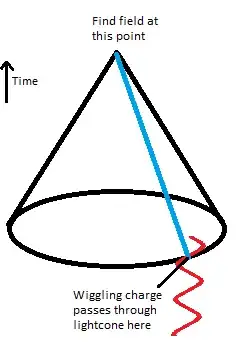Other anwers here are correct, but there is another perspective that might be helpful, which is to consider the electromagnetic field in terms of retarded potentials. One way of solving the electromagnetic equations is to use Jefimenko's Equations, which say that the electromagnetic field at a given point in spacetime can be calculated from the charge distribution (and its rates of change) on the past lightcone of that point.
The past lightcone of a point is all the points in space and time from which a light ray would arrive there at exactly that moment. If an observer is located there, it describes all the events they can see (with lightspeed signals) at that moment.
So if you consider some point just as a radio wave passes through it, you can work out the field there by drawing a lightcone from that point back to the beginning of the universe. All the charged particles whose paths cross that lightcone contribute. We simply add up all the contributions to find the field. For our radio wave, when you trace the lightcone back into the past, we find it passes through the antenna that emitted the radio wave - the moving charges in the wire are the source of the electromagnetic field.
So, although there are no charged particles close (in conventional terms) to the point where the radio wave is passing, the charged particles are there on the past light cone. Since in relativity the distances shrink to zero as you approach the speed of light, there is a sense in which the charges are in fact extremely close!

This next bit goes well beyond your question, but I should probably mention that there is a spot of controversy around the idea retarded potentials, which is to do with where the time asymmetry comes from. Maxwell's equations are time-reversible, so if we can derive the potential at a point from the past lightcone, then we ought to be able to derive it from the future lightcone using the advanced potentials in exactly the same way. So the question is, why do we not see the future? Why does the effect go only one way?
The answer seems to be to do with a point I skipped over earlier, which is that Jefimenko's equations also have a 'boundary term', describing the field that comes from 'infinity'. You have to do the integration over a defined region, and the result is the sum of what is going on inside the region (moving charges and so on), plus what enters the region from outside (the boundary conditions). Our observations of the universe indicate that the boundary term contributed by the start of the universe (the past) is zero, and the boundary term contributed by the end of the universe (the future) is whatever it needs to be to cancel all the stuff going on on the future lightcone. It's still a tiny bit mysterious. Richard Feynman and John Wheeler did some work trying to figure out why, but I don't think Feynman in particular was ever really satisfied with the explanation.
